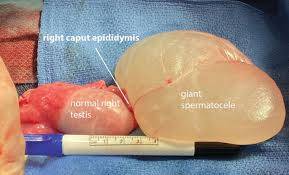Spermatocele
A spermatocele, also known as a spermatic cyst, is a fluid-filled sac that develops in the epididymis, the coiled tube located above and behind the testicle. It usually contains milky or clear fluid with dead sperm. Spermatoceles are benign and typically painless.
---
Causes
The exact cause of a spermatocele is not well understood, but potential factors include:
1. Blockage in the Epididymis:
Obstruction of sperm-carrying tubes can lead to fluid buildup.
2. Injury or Trauma:
Damage to the scrotum may disrupt normal sperm drainage.
3. Infections:
Infections, such as epididymitis, may contribute to cyst formation.
4. Congenital Factors:
Some individuals may be predisposed to developing spermatoceles.
---
Signs and Symptoms
1. Painless Lump:
A soft, smooth, and movable mass in the scrotum, usually above the testicle.
2. Scrotal Swelling:
The affected side of the scrotum may appear enlarged.
3. Discomfort or Heaviness:
Rarely, larger spermatoceles may cause mild discomfort or a feeling of heaviness.
4. No Systemic Symptoms:
Fever or other systemic signs are not associated with spermatoceles unless accompanied by infection.
---
Effects
1. Rare Fertility Issues:
In uncommon cases, large spermatoceles might affect sperm transport, leading to infertility.
2. Physical Discomfort:
Larger cysts may press on surrounding structures, causing discomfort.
3. Psychological Impact:
Anxiety over the presence of a lump, even if benign.
4. Risk of Infection:
Rarely, a spermatocele may become infected, leading to epididymitis.
---
Solutions
1. Diagnosis:
Physical Exam: To assess the size, location, and mobility of the lump.
Ultrasound: To confirm the diagnosis and differentiate it from other scrotal masses, such as hydrocele or tumors.
2. Observation:
Most spermatoceles do not require treatment if asymptomatic.
3. Medications:
Pain Relievers: Over-the-counter medications like ibuprofen for mild discomfort.
Antibiotics: If infection occurs.
4. Surgical Intervention:
Spermatocelectomy: Surgical removal of the spermatocele for larger, painful, or bothersome cysts.
Performed under local or general anesthesia.
May carry risks such as infection or scrotal damage.
5. Minimally Invasive Procedures:
Aspiration (draining the fluid) may be used, but recurrence is common.
6. Lifestyle Adjustments:
Wearing supportive underwear can reduce discomfort from larger cysts.
---
Prevention
There are no guaranteed methods to prevent spermatoceles, but regular self-examinations and prompt treatment of scrotal injuries or infections may help minimize risks.
---
Prognosis
Spermatoceles are typically harmless and do not progress to cancer or other severe conditions. They rarely cause complications, and surgical treatment is effective for symptomatic cases. Regular follow-ups ensure that no other issues are developing. If you notice a lump or experience discomfort, consult a healthcare provider for proper evaluation.


